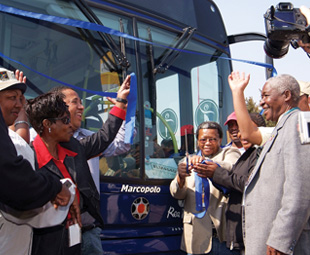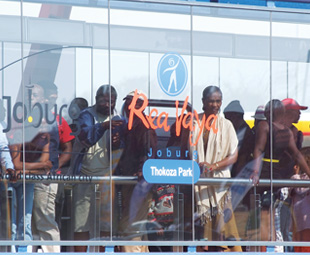Bringing on BRT

August is BRT awareness month, as the City of Johannesburg prepares to launch the Rea Vaya Starter Service on 30 August 2009. The road to bus rapid transit (BRT) implementation in South Africa has been a long one. As the flagship public transport project in the City of Johannesburg’s extensive transportation upgrades currently gets underway, Rea Vaya has received a lot of attention of late, most notably as a result of strong opposition to the system from local taxi associations.
It now appears as though repeated delays of the implementation of Rea Vaya as negotiations with taxi associations continued are at an end. The Starter Service, a precursor to Phase 1A of the system, will officially go online on 30 August 2009, even though a final agreement between the taxi industry and the City Of Johannesburg has not yet been reached.
Speaking at a media briefing launch on 12 August 2009, councillor Amos Masondo, executive mayor of Johannesburg, revealed why the system will no longer be placed on hold.
“[There are] a mere 302 days left before the first ball is kicked at the 2010 FIFA World Cup [Soccer] tournament,” he said.
“The City of Johannesburg is required to and has a responsibility to ensure a safe, secure and affordable public transport system for residents and visitors to all the match venues. We will use the pressure that comes with the 2010 World Cup to build a world-class transport system for all.
“We need a public transport system that is fast, efficient, secure, affordable and environmentally friendly,” he continued. “We need a world-class public transport system for a world-class African city. The BRT Rea Vaya is part of this overall effort.”
The effort Masondo is referring to includes the Gauteng Freeway Improvement Project (GFIP), the Gautrain and its feeder buses, upgrading OR Tambo International Airport and the upgrading of taxi ranks in the inner city, although BRT is the most urgent in terms of the upcoming FIFA World Cup Soccer tournament.
The World Cup is not the sole or even most important reason behind these upgrades, however. As South Africa continues to rebuild its shape and image following the end of the old regime, public transport remains a core issue, one which must be addressed and resolved for the millions of people who require this service, particularly in the country’s largest city and economic and industrial hub.
The City of Johannesburg hosted a public transport summit on 15 August at Nasrec Expo Centre, with a Fun Day held the following day at Thokoza Park, during which the official bus unveiling took place.
The aim of both events was to educate Johannesburg’s residents and public transport users about Rea Vaya, how the system works and how it should benefit its most important stakeholders: its passengers.
“Did you know that the citizens of our city undertake a total of 3.5 million trips every day?” asked Masondo during the public transport summit. “Nearly half (47%) is by public transport, of which 773 000 (72%) trips are by minibus taxis, 230 300 (14%) are by train and 148 050 (9%) are by bus.”
The city’s executive mayor had already drawn attention to the country’s current public transport picture, most notably the fact that the legacy of apartheid special planning meant the poor were forced to live in areas far from their workplace, with very little historical investment made in public transport infrastructure.
“Today, most city dwellers – around two-thirds – do not have private motor cars and are completely reliant on public transport,” he said.
“From this current picture it is clear that we need a public transport system that is not only effective and reliable, but that meets the needs of all our citizens.
 “We stand before a crossroads. Yes, we can continue to merely invest in our existing road infrastructure to cater for the growing number of cars on our roads, or we can follow in the footsteps of other successful cities in the world and take a more holistic view, providing alternatives, encouraging public transport, as well as non-motorised transport such as cycling and walking, and critically, integrating our different modes of transport to form a cohesive sustainable whole.”
“We stand before a crossroads. Yes, we can continue to merely invest in our existing road infrastructure to cater for the growing number of cars on our roads, or we can follow in the footsteps of other successful cities in the world and take a more holistic view, providing alternatives, encouraging public transport, as well as non-motorised transport such as cycling and walking, and critically, integrating our different modes of transport to form a cohesive sustainable whole.”
However, despite such sweeping rhetoric, taxi operators have continued to voice their opposition to the system, threatening violent protests even as the launch continues as planned at the end of the month.
Masondo has assured the public that negotiation sessions with the taxi industry relating to Phase 1A of the system started on 5 August and will continue until the matter is resolved. Operators from nine out of 10 affected associations were present at the first meeting and the door remains open for all those wishing to participate in the process.
“BRT operations aim to be ‘employment-neutral’, meaning that all jobs ‘lost’ from the current public transport operators will be replaced with new jobs in the BRT,” he explained.
“Most informal jobs in the taxi industry will be replaced by formal jobs in the BRT operating companies, with properly regulated conditions of employment and improved working conditions such as shorter hours.
“The City of Johannesburg is committed to offer local operators that will be affected by the introduction of the BRT a stake in a new Bus Operating Company; a stake and jobs in one or more of the station management companies, as well as potential jobs, investment and ownership in a variety of companies linked to the BRT. By doing this we are ensuring that operators are not worse off than at present,” he continued.
“We are obliged to ring fence the bus operating contract for affected operators in terms of national transport legislation.
“Government is committed that the taxi industry should be the nucleus and significant beneficiaries, which will enable them to be part of a formalised business and to get shares in a bus company with no equity other than proof that they are incumbent operators.
“We are also working with industry and other spheres of government to establish how the industry can further gain from the ‘BRT value chain’, for example through bus manufacture and maintenance, or depot construction. The law does not allow us to ring fence these opportunities, but we can look at preferences.”
Following President Jacob Zuma’s capitulation to the taxi industry at a Santaco (SA National Taxi Council) Summit held in Midrand in April of this year, during which he agreed to postpone BRT negotiations, hopes were low that the system would ever actually get off the ground, despite strong public support and millions of rands already invested in the project.
The announcement of the launch, despite continuing debate, offers some hope that BRT will in fact be unrolled according to schedule, however.
Although the Starter Service has been introduced to pilot the system and iron out any teething problems before negotiations are finalised with taxi operators, the fact that the system is moving forward – despite taxi threats – is an indication of how serious the City of Johannesburg is about its plans; serious enough to no longer be bullied by the taxi industry, at any rate.
Some concessions have been made, however. The Starter Service will only be run by a temporary company for no longer than six months, after which time Johannesburg hopes to sign an agreement with a newly established Bus Operating Company made up of taxi operators that have been affected by the introduction of BRT, thereby upholding the city’s promise to protect existing taxi operators.
As D-Day fast approaches, however, we can only hope that the routes poised to be put in service are not destroyed or passengers intimidated before Rea Vaya can really get off the ground.
Published by
Focus on Transport
focusmagsa



